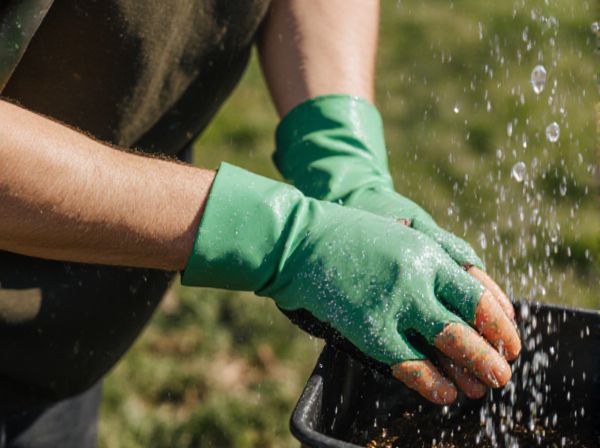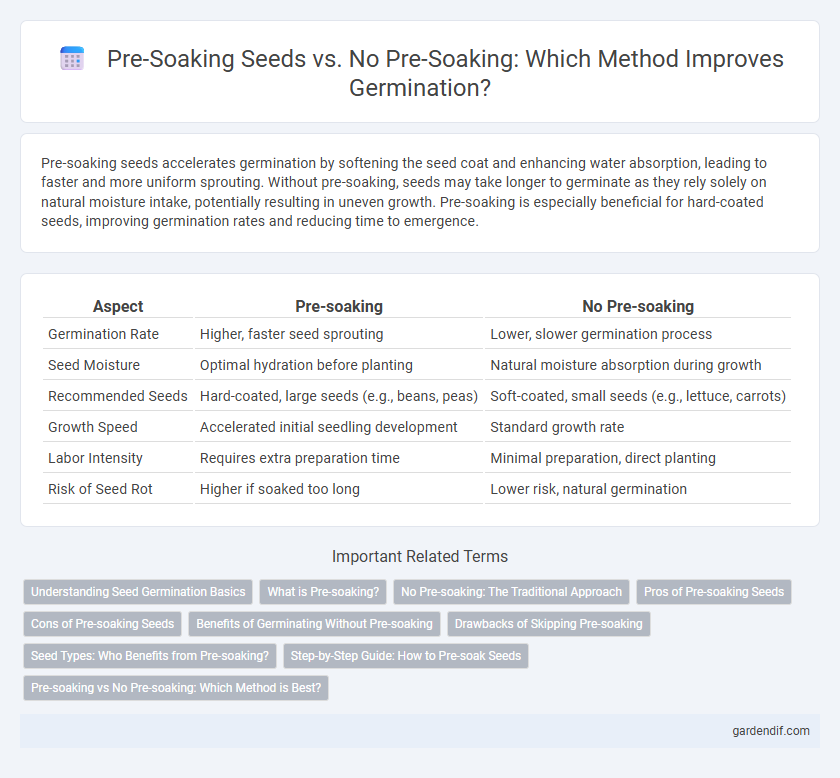
Pre-soaking vs No pre-soaking Illustration
Pre-soaking seeds accelerates germination by softening the seed coat and enhancing water absorption, leading to faster and more uniform sprouting. Without pre-soaking, seeds may take longer to germinate as they rely solely on natural moisture intake, potentially resulting in uneven growth. Pre-soaking is especially beneficial for hard-coated seeds, improving germination rates and reducing time to emergence.
Table of Comparison
| Aspect | Pre-soaking | No Pre-soaking |
|---|---|---|
| Germination Rate | Higher, faster seed sprouting | Lower, slower germination process |
| Seed Moisture | Optimal hydration before planting | Natural moisture absorption during growth |
| Recommended Seeds | Hard-coated, large seeds (e.g., beans, peas) | Soft-coated, small seeds (e.g., lettuce, carrots) |
| Growth Speed | Accelerated initial seedling development | Standard growth rate |
| Labor Intensity | Requires extra preparation time | Minimal preparation, direct planting |
| Risk of Seed Rot | Higher if soaked too long | Lower risk, natural germination |
Understanding Seed Germination Basics
Pre-soaking seeds enhances water absorption, activating enzymatic processes essential for seed germination. Seeds without pre-soaking rely on natural soil moisture, often leading to slower germination rates and uneven sprouting. Understanding these differences aids in selecting optimal germination techniques for various seed types and environmental conditions.
What is Pre-soaking?
Pre-soaking involves immersing seeds in water for a specific period before planting to initiate the germination process by softening the seed coat and activating enzymes. This technique enhances water absorption, leading to faster and more uniform seed sprouting compared to seeds sown without pre-soaking. Agricultural studies confirm that pre-soaked seeds often exhibit higher germination rates and improved seedling vigor.
No Pre-soaking: The Traditional Approach
No pre-soaking in germination relies on the seed's natural moisture absorption process, often resulting in slower but steady growth. This traditional approach enhances seed resilience by allowing gradual water uptake, which can improve overall seedling vigor in certain crop varieties. Farmers favor no pre-soaking to maintain seed integrity and reduce the risk of fungal infections commonly associated with excess moisture.
Pros of Pre-soaking Seeds
Pre-soaking seeds accelerates germination by softening the seed coat, allowing water to penetrate more easily and activate metabolic processes. This practice improves germination rates, especially for hard-coated or older seeds, leading to more uniform seedling emergence. Enhanced moisture absorption during pre-soaking reduces the time required for seeds to sprout, promoting faster and more vigorous plant growth.
Cons of Pre-soaking Seeds
Pre-soaking seeds can increase the risk of fungal infections and seed rot due to excess moisture exposure. Some seeds may experience reduced oxygen availability during pre-soaking, leading to impaired germination rates. The process requires additional time and careful water temperature control, which can complicate seed preparation.
Benefits of Germinating Without Pre-soaking
Germinating seeds without pre-soaking promotes natural dormancy-breaking processes, enhancing seed vigor and resilience by allowing gradual water absorption in the soil. This method reduces the risk of seed rot and fungal infections often associated with prolonged moisture exposure during pre-soaking. Avoiding pre-soaking simplifies the germination process and supports the development of robust root systems, leading to healthier seedlings.
Drawbacks of Skipping Pre-soaking
Skipping pre-soaking seeds can significantly delay the germination process by preventing the seed coat from softening, which slows water absorption essential for sprouting. Without pre-soaking, seeds may exhibit uneven germination rates, leading to inconsistent seedling growth and reduced overall yield. This drawback is particularly critical for hard-coated seeds like beans or peas, which require moisture exposure to break dormancy effectively.
Seed Types: Who Benefits from Pre-soaking?
Pre-soaking seeds accelerates germination by softening the seed coat, especially benefiting hard-coated seeds like beans, peas, and lentils. Delicate or small seeds such as lettuce and carrot may not require pre-soaking, as they germinate quickly without intervention. Pre-soaking is most effective for seeds with impermeable or tough outer layers that delay water absorption and sprouting.
Step-by-Step Guide: How to Pre-soak Seeds
Pre-soaking seeds accelerates germination by hydrating the seed coat, making water absorption easier and triggering metabolic processes. To pre-soak, place seeds in a bowl of lukewarm water for 6 to 12 hours, depending on seed size and type, then drain and plant immediately. Skipping pre-soaking may extend germination time but is suitable for hardy seeds that naturally break dormancy without additional hydration.
Pre-soaking vs No Pre-soaking: Which Method is Best?
Pre-soaking seeds accelerates germination by softening the seed coat, allowing water absorption and enzymatic activity to begin sooner, resulting in faster and more uniform sprouting. In contrast, no pre-soaking relies on natural moisture uptake, which can delay germination and lead to uneven seedling development, especially in hard-coated or larger seeds. Optimal germination rates often occur with pre-soaking, making it the preferred method for species requiring swift and consistent emergence.
Pre-soaking vs No pre-soaking Infographic

 gardendif.com
gardendif.com